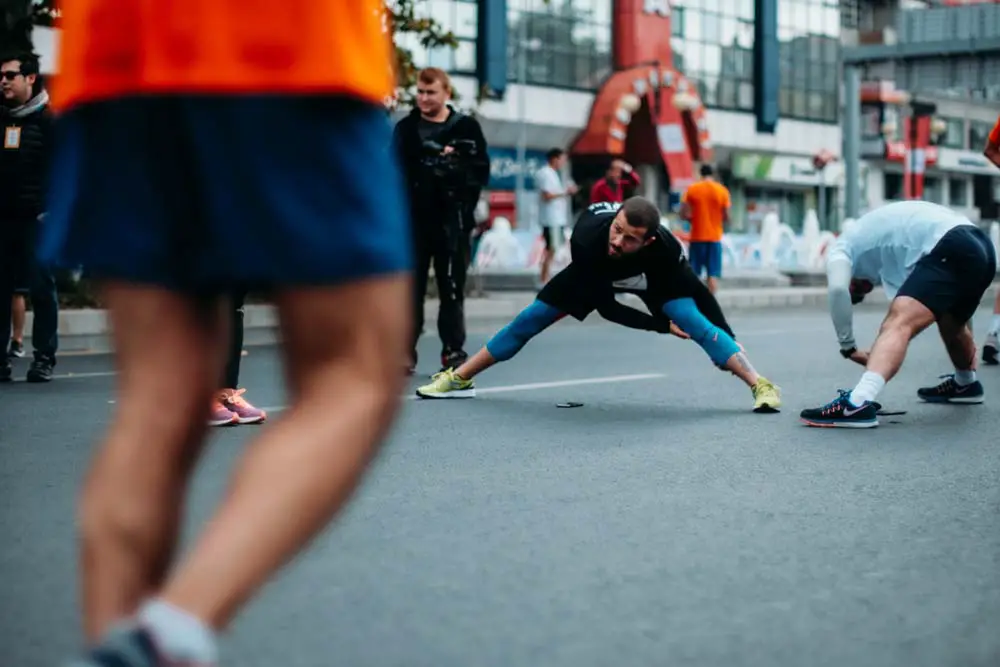This post contains affiliate links.
The majority of runners know the importance of stretching but only a few know the proper way to use it. One of the most common questions runners ask is: how long should you stretch? Having interned as a physical therapist in sports rehab, I’ve learned the common practices of stretching for runners.
You can stretch anywhere from 30 seconds to 5 minutes per muscle group depending on the goals of the stretching. Runners should aim only to be flexible enough to maximize stride length and correct running form. Anything more than that can be detrimental to running performance.
Ahead, we will discuss how long should you stretch based on your own level of tightness as well as some important things you should know about stretching duration.
Stretching Duration For Runners

A lot of runners have this idea that there is a magic number to stretching duration.
But the truth is, the duration of your stretch largely depends on your personal level of tightness. For some, they might not even need it at all and actually have to avoid it.
The duration of your stretches (or the need for it) should be based on your individual needs as a runner and not some arbitrary number.
For runners who feel tight to the point where there is a decrease in stride length or there are some compensatory movements in your running form (like your hips rotating because your hip flexors are too tight), then stretching should be done.
For how long? “Some people will feel a release after only 30 seconds while others need closer to 4 to 5 minutes“, says Dr. Michael Rowe of Spinecare.
But for runners who can maximize their stride length and don’t seem to have a problem with changes in posture, then you can keep it to a minimum or non at all.
For example:
I have a tight hip flexor from doing tons of toes-to-bar, running, and sitting. I typically stretch my hip flexors for 3 mins each day while other joints I only stretch for 60 seconds 2-3 days a week.
Why is that? Because the tightness of my hip flexors causes compensatory movements which is why I have to be aggressive in stretching them.
They’re too tight and causing problems so they need to be fixed.
On the other hand, I only stretch my other joints to maintain their flexibility which is why I stretch them less.
Related post: Should You Stretch Before Or After Running?
Can You Be “Too Flexible” As A Runner?
We’ve been taught that flexibility is great and that we all should be flexible. However, that’s not always the case for all sports, including running.
Having some tightness allows your body (legs in particular) to act as a spring thereby improving your running economy and decreasing your energy expenditure.
Being too flexible, as in being able to stretch more than the normal ranges of motion, can decrease your ability to “bounce through your stride” requiring you to use more of your energy and make your muscles work harder.
As a general rule, you only have to be within the normal ranges of motion and have no compensatory movements when you run. Anything more than that is “too flexible” for a runner.
How Often Should You Stretch?
How long you should stretch is not the only thing you should be thinking about. In fact, the frequency of your stretches may have more to do for your flexibility than how long you hold your stretches.
A review published in 2018 examined the effects of stretching volume on the range of motion.
They found that the time spent stretching per week on a particular muscle group if applied for 5 minutes or more seems fundamental to increasing the range of motion.
Whereas the time spent stretching on a single session does not seem to have any significant effects on the range of motion.
In other words, if you stretch your hamstrings for 60 seconds five days a week, you will improve your hamstring flexibility faster than stretching it for 5 minutes once a week.
The same total duration, but different results.
Experts recommend that you stretch every after you run to maximize its benefits. But you can stretch up to 7 times a week if you believe you need more flexibility.
So as a general rule, if you want to improve your flexibility on a certain muscle group faster, you need to stretch it more frequently.
Stretching Tips For Runners
- Do static stretching after training
- Don’t stretch to the point of pain, stretch only up the the end range of motion
- If you need flexibility, be consistent – 60 seconds a day 5 days a week is better than 5 minutes in a single session
- Stretch only what needs to be stretched – If you’re “too flexible”, avoid stretching for long durations
- Breathe while you stretch
- If you find holding a stretch for 60 seconds hard, consider breaking it up to 3 sets of 20 seconds
Final Thoughts
Most runners and coaches would agree that stretching is important. It helps runners maintain flexibility, prevent injuries and correct compensatory movements that could be detrimental to running performance.
The duration of your stretch, however, should be a targetted approach and not some random number you do for the sake of stretching.
If you want to dial in your performance, I recommend that you hire a qualified coach or physiotherapist to help you with assessing your needs.
This blog post was reviewed by a registered Physical Therapist.

